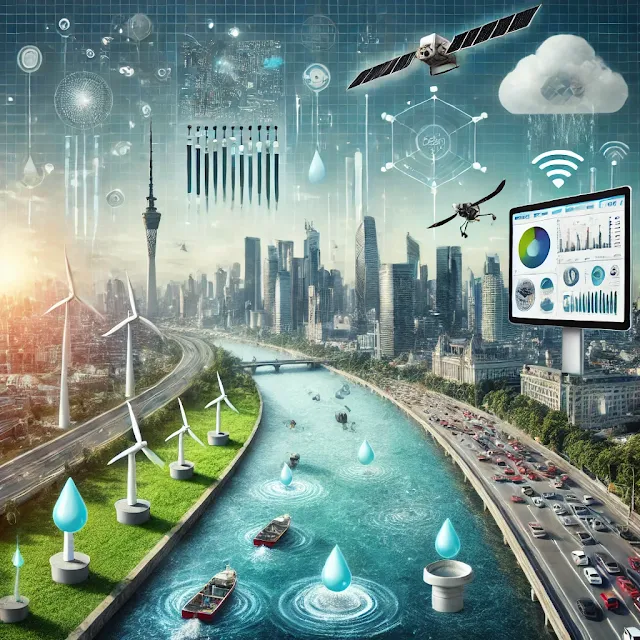Environmental Sensing: Revolutionizing Air and Water Monitoring
Introduction:
Environmental measurement technology monitors and manages natural resources. It significantly contributes to controlling and reducing environmental pollutants. Also, these devices play a crucial role in renewable energy systems. Additionally, it tracks climate change, benefiting individuals, society, and the surrounding environment by collecting large datasets for real-time and on-demand use. |
| advanced environmental sensing system |
In this article, we will go through environmental sensing technologies to understand their definition and impact on improving the environment, especially in the air and water fields. Also, we will discuss the challenges facing environmental sensing and its future outlook.
Examples of Devices Used in Environmental Applications.
These devices include temperature sensors, pressure sensors, and humidity measurements, which are used to assess air purity and efficiency, as well as in water treatment plants. It is also used to measure the intensity of solar radiation to produce electricity from photovoltaic panels.There are also other sensors used to monitor water quality in water treatment plants, such as total organic carbon (TOC) sensors, which measure organic pollutants in water, PH sensors, which assess acidity levels, and conductivity meters, which test the concentration of dissolved salts in water.
There are also specialized devices for measuring and monitoring environmental elements, such as dust measurement devices and gas emission analyzers used at the entry points of heavy industries, including oil refineries, iron, and cement industries.
Furthermore, they are used to measure wind speed in wind turbines that produce electricity from wind energy. Integrating modern applications, such as Artificial Intelligence (AI), with these devices, has facilitated numerous complex operations for analyzing data and figures, leading to precise results that can be utilized in environmental studies.
Impact of Modern Technology on Environmental Sensing.
Moreover, using artificial intelligence has brought a significant breakthrough in climate forecasting, enabling decision-making entities to develop future and sustainable plans that align with current and future conditions based on climate predictions and environmental studies.Advancements in environmental monitoring devices have enhanced the efficiency and accuracy of these processes. Technologies such as LiDAR, infrared devices, and organic measurement instruments have helped identify areas where deforestation has occurred and detect greenhouse gas emissions.
How Advanced Sensors Are Improving Air Quality?
Environmental measurement devices and sensors track and monitor air pollutants such as dust, carbon monoxide, and nitrogen oxides around the clock, whether in urban or industrial environments. This helps officials identify areas with critical readings and develop plans and solutions to mitigate pollution. Some examples of these solutions include:- Installing filters, precipitators, and bag filters in the industrial plants to isolate dust and prevent its emission from chimneys and industrial zones.
- Installing automatic ventilation units in air conditioning systems for enclosed spaces. These units activate when oxygen levels drop or carbon monoxide levels rise.
- Implementing emission control units to reduce carbon monoxide and nitrogen oxide emissions from industrial chimneys.
- Regulating traffic flow and reducing congestion in densely populated cities to minimize toxic emissions in crowded areas.
- Replacing gas-powered cars by Electric Vehicles (EVs) to reduce the emission of nitrogen oxides and carbon monoxide.
- Encourage rooftop gardening and the expansion of vertical gardens, enhancing air quality and reducing pollutants.
- Stronger Environmental Regulations: Governments can impose stricter emission limits and enforce policies like congestion charges to cut pollution.
How Advanced Sensors Help Improving Water Quality?
Modern sensors and precise devices, such as Total Organic Carbon (TOC), PH sensors, and conductivity meters, pave the way for developing short-term and long-term plans and studies to improve water efficiency. Here are some key solutions:- Reverse Osmosis (RO) to remove salts and other pollutants from seawater in desalination plants.
- Rainwater Harvesting by promoting rainwater collection for reuse to reduce the dependency on groundwater.
- Install Activated Carbon Filtration in water treatment plants and houses to remove organic pollutants and chlorine.
- Pollution Control Regulations by enforcing strict wastewater discharge laws, reducing industrial pollution in rivers and lakes.
- Membrane Bioreactors (MBRs) enable advanced wastewater treatment facilities to treat sewage efficiently, producing high-quality recycled water.
- Enable Smart Water Monitoring by applying IoT-based sensors to continuously monitor water quality in real-time, detecting contamination early.
- Strengthen pollution control regulations by enforcing stricter rules to reduce industrial pollution in rivers and lakes.
Challenges of Environmental Sensing Technologies.
Despite the advantages and benefits of environmental measurement devices, they face several obstacles and challenges that may slow the adoption of these modern systems. Some of these challenges include:- Decreased accuracy and efficiency over time. Most of these devices experience performance degradation with prolonged use, affecting monitoring and decision-making. Therefore, regular calibration is required to maintain accuracy.
- Constant environmental changes. Continuous changes in factors such as humidity, temperature variations, and pollution intensity can impact the efficiency and performance of environmental sensors.
- High costs in large-scale deployments. In regions requiring huge measurement devices, limited resources can hinder the expansion and improvement of sensor networks.
- Cybersecurity and data privacy risks. Using IoT technology increases the risk of cyberattacks, potentially exposing vast amounts of environmental measurements and sensitive data to hacking.
Future Outlook for Environmental Sensing Technologies.
It is driven by nanotechnology, artificial intelligence, and the Internet of Things (IoT), leading to more efficient environmental monitoring systems for tracking air and water pollutants. This advancement provides decision-makers with a faster and more comprehensive picture, enabling them to develop strategic plans and alternative solutions to adapt to future climate conditions and control pollution effectively.Conclusion.
Environmental sensing technologies transform air and water monitoring by providing real-time pollution control and resource management. When Advanced sensors are combined with AI and IoT, they enhance accuracy and efficiency in climate forecasting, industrial emissions reduction, and water treatment.Despite challenges like sensor degradation and cybersecurity risks, future advancements in nanotechnology and advanced monitoring systems will drive more effective and sustainable environmental solutions.













No comments:
Post a Comment